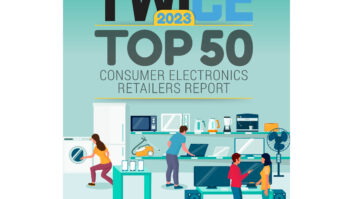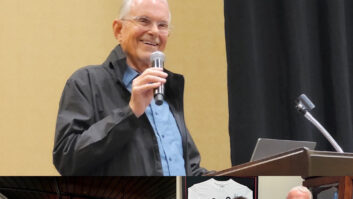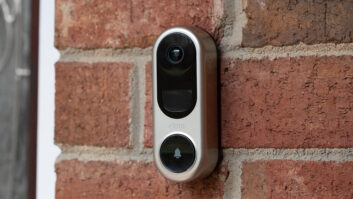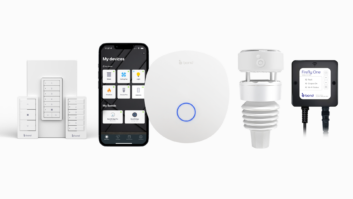MINNEAPOLIS –
It was two years ago amid the fallout
from the global financial crisis that Best Buy CEO Brian
Dunn took the reins of Earth’s largest CE retailer.
His first order of business, akin to catching falling
knives, was managing the aggressive growth plans that
had been put into place both here and abroad before the
world economy buckled.
But faced with unprecedented competition online that
was fomented by the very technology his company sells,
Dunn also launched a laundry list of initiatives to leverage
the retailer’s formidable multichannel capabilities and ensure
its leadership in a connected world.
Throughout the challenges the one-time sales associate
has maintained a shirt-sleeve management style borne
of his days on the store floor, which has endeared him to
his 180,000 far-flung employees. The affection was evident
during a recent store visit when Blue Shirts vied for
a chance to be photographed with their chief executive.
Dunn’s no-nonsense manner extends to his unassuming
corner office, where he shared with TWICE his vision for
Best Buy in the brave new world of price transparency, online
efficacy and an always connected consumer. — Alan Wolf
TWICE:
How is Best Buy addressing market share
gains by online-only retailers?
Dunn:
For me it isn’t a question of Internet vs. brickand-
mortar — it’s Internet and brick-and-mortar. I do not
believe that physical alone is going to be enough, nor do I
believe that digital alone will suffice. It is how those things
come together, and that’s how people are living today.
influences 60 percent of the time we ring
the register in the store. The customer’s been to
and done some research, taken a look at what’s available,
and increasingly we see that being important.
I’ll give you an example of something we’re selling right
now: “Batman Arkham City” launched last month, and
Best Buy has exclusive content. We have a Robin fight
game and we have a couple of exclusive maps, so if customers
pre-ordered the gaming disc from us, they got the
code for a download for that additional content. Increasingly
we’re going to see physical and digital interacting.
I hear the statement all the time that “Boy, the Internet
is going to devour the entire physical world.” I simply don’t
believe that. I believe people want to see the television
screens they’re going to be enjoying in their homes. I believe
people like to see the different phones side by side
and decide which smartphone is the best phone for them.
They like to see the form factor of the computers.
There are times and places where a digital transaction
lickety-split will solve the day. There are also times when
only a physical interaction with the product is going to be
able to answer the questions or create the set of solutions
that you’re going to want.
TWICE:
What’s the ideal channel mix for Best Buy?
Dunn:
I don’t have a hard number in my head. I certainly
have targets for online, on-phone, in the store — for all the
various channels we have. But I really think it’s for the customer
to determine what they want, where they want it,
and how they get it.
Our job is to be where the customer needs us to be,
and the best way to do that is to be where they are. And
that’s what we’re doing. That’s why you see us doing work
with Facebook, that’s why you see our presence on Twitter,
that’s why you see our network of stores you know
so well, and that’s why dot-com’s so important. We even
have a media network now, Best Buy On, where we present
information and advertising.
TWICE:
How do you contend with smartphone price
comparison apps?
Dunn:
Increasingly you will find us priced competitively
with pure-play retailers on the SKUs we carry in our
stores. Our initial position has always been that we are
always there on any physical prices, and increasingly we
are expanding that so that we are more actively engaged
with online and sharpening our pricing there, and you will
continue to see us drive better and sharper pricing in all
the channels we play in.
TWICE:
How?
Dunn:
We’ve done a couple of things. We launched
Marketplace this year, which allows us to bring different
providers in through
and has allowed us to
get even sharper on pricing, [while] our extended SKU assortment
and our supplier direct fulfillment has allowed us
to broaden the range of offerings.
TWICE:
How will you continue to get footprints in the
stores now that traditional traffic drivers like physical music
and movie media are fading?
Dunn:
We have over a billion customer visits
a year between online and in our stores, and
one of the challenges we face is with the deterioration
of sales of physical music, the shiny
discs. What do we do in place?
What you’ve seen us do in the center of our
store is roll out things like Best Buy Mobile, like
our digital imaging boats, like our gaming solution
now. Increasingly, Best Buy is becoming
a sort of digital playground, and I think that we
find that to be very, very compelling for our future
because while some of the technologies
that have been central to this industry for a long
time — physical media as an example — are fading,
digital’s exploding. And we’re just getting
started with what we’re going to be able to do
with digital media and digital technologies.
So we are very much making our store an experiential
place where people can explore, touch, feel and
play with the products.
TWICE:
How does the new connected store format
support that?
Dunn:
It sounds so trite, it’s so obvious, but consumers
are really gravitating toward “How do I test
drive these connected technologies?”
One of the demonstration areas we have set up in our
connected stores is the Samsung AllShare model, where
you can distribute from the phone to the tablet to the television
screen. You can’t go into one of those stores and
not find a customer who’s playing with that and is really
impressed with how you distribute that content.
It’s that sort of thing that we need to bring to life to
show our customers the thrill of what’s available today
at their fingertips. And you will see us move aggressively
toward deploying what we’ve learned in our
stores starting next year.
TWICE:
What will the chain look like in ten years?
Will there be fewer and smaller
stores?
Dunn:
It’s very hard for me to
tell you with precision what we’ll
look like ten years from now. We
will still have a big number of
physical stores. I don’t know if it
will be 1,100, or 2,000 with our freestanding Best Buy
Mobile stores, or 1,200 because nodes have shifted.
What I can tell you for certain is that we will have what
it is we need; big footprint, small footprint, medium
footprint and digital, digital, digital.
We’ll do what we always do — we’ll be where the
customers need us to be, and we will be the leading
multichannel retailer in the world, period. We will bring
the latest and greatest solutions to our customers.
We’ll bring great value and great price. We’ll bring
great information, great knowledge. We’ll bring a great
and differentiated experience.
Ten years from now I don’t think there’ll be an area
of our lives that this digital connected technology’s not
touching. We’ll have in-home solutions for everything
from energy management to healthcare to transportation
and on and on and on and on. All these industries
are going to be dramatically impacted by this, and
we’re going to have a big role to play.
TWICE:
TV has traditionally been the backbone of
CE retail. How are you restructuring your business to
compensate for slowing sales and severe price and
margin compression?
Dunn:
TV is a critically important part of the portfolio
of products and services we sell. TV remains a
multibillion-dollar business for us. Television has just
had over the last seven or eight years the largest adoption
of new technology certainly in the history of TV
since it’s been a “mature” business.
So we’re in a very predictable trough on the backside
of that huge adoption that is exacerbated by the worst
economic events since the Great Depression. Yes,
television to some degree has slowed down. However,
it remains as I’ve said a multibillion-dollar business,
and our higher-end, or more fully featured, television
business is doing very, very well. On our last quarterly
call we talked about positive comps that were certainly
over 25 percent. That business is growing and growing
rapidly, and has been for some time now.
As those price points start to contract and those
technologies start to compress, they start to fit into the
mainstream space, and it is a very good indicator for
what television sales look like a year and two
years from now.
Listen, there is nothing more
central to connected living, to
the American home than the
television. I’ve described it as
the modern-day hearth. It’s what
families gather around, and share experiences. Sundays
in my house — and I’m blessed that my kids and
my wife are all big football fans — are a multimedia experience,
all centered around that biggest of screens
watching football, something we all happen to love.
And that’s not going away.
Nor is the fact that it’s a visceral technology — you
must see it to appreciate it, and no two pictures are
exactly the same.
So, yes, the rate of sales has slowed down over the
last several years. I don’t see that as permanent, I see
it as temporal, and at Best Buy we’ve always built this
business for the long haul. We’ve never overreacted to
temporal disturbances, and we have no intention of doing
that. TV remains an important part of what we do, and
we’re quite thrilled to be part of the television business.
TWICE:
What are your key strategic priorities?
Dunn:
We are enormously focused on our online
business, enormously focused on services, as you
would expect, and we are fanatically interested in
the work we’re doing in China, and we’re very, very
pleased with the team there.
TWICE:
In hindsight was Best Buy overly aggressive
overseas?
Dunn:
Let me be really, really clear about this: What
happened in 2008, when the recession started over
that Lehman weekend, changed the world. So decisions
made before 2008 were completely appropriate
for the time. And post-2008, in this new world we’re
working in, there are different sets of choices which
you’ve seen me execute against.
It’s not that I’m second-guessing any of the choices
that were made prior to that. It’s that I believe the world
fundamentally shifted that weekend, and businesses
that don’t take that moment to really roll up their
sleeves and look at their model end-to-end in all their
businesses will have a tough time ahead.
There’s two ways to look at it: You can say, well, it’s
a temporal event and things are gonna get better, so
let’s plan our business for when things get better, and
we’ll get that real nice tailwind. I believe when you have
seismic events like that you need to look at your model
end-to-end and make sure you are invested in the places
where you have the highest probability of being successful.
And what I have done is focused the portfolio.
TWICE:
Will things eventually get better?
Dunn:
I am an optimist. I believe in the human spirit
and that mankind will prevail, in spite of itself sometimes.
I absolutely believe that our country will find a
way — it always has, and I’m a firm believer that it will.
This is a long march through a very, very challenging
time as we find the steps we need to take to strengthen
our economy and the world’s economy.
So, yes, of course it will get better, but this isn’t a
time for wait and hope. This is a time for people to dig
in, roll up their sleeves and get very, very connected to
their customers.













